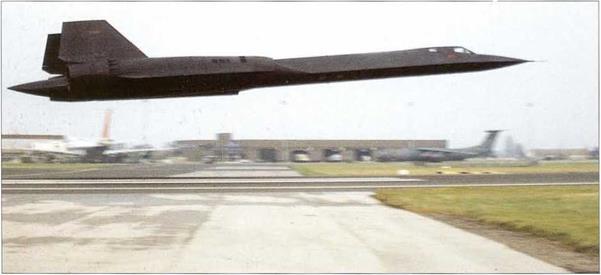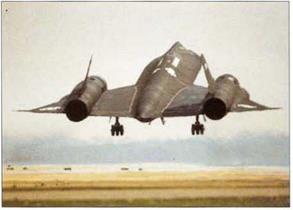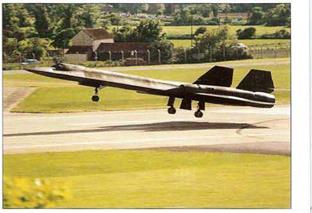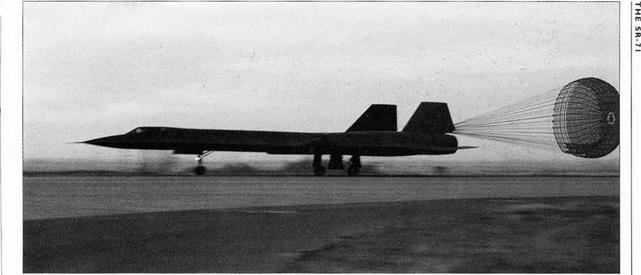Losses
Progress came at a heavy price. The first SR-71 loss occurred on 25 January 1966, when Bill Weaver and his test engineer Jim /.waver took off from Edwards in SR – 71 A ‘952. After in-flight refuelling, ‘Dutch 64’ climbed back to cruising altitude. While in a 15-degree right back turn, manually controlling the right forward bypass doors at Mach 3.17 and between 77-78,000ft, Weaver experi
enced a right inlet unstart. Bank angle immediately increased from 35 to 60 degrees and the aircraft entered a pitch-up that exceeded the restorative authority of the flight controls and SAS. The aircraft disintegrated, but miraculously Weaver survived; unfortunately Jim Zwayer was killed in the incident.
The SR-71 prototype was written off on 10 January 1967, during an anti-skid brake system evaluation at Edwards AFB, the Lockheed test pilot Art Peterson escaped with a cracked disc in his back. Three months later, on 13 April, Beale lost SR-71A ‘966 flown by Capts Earle Boone and RSO Butch Sheffield follow ing a stall and pitch-up. Both men safely ejected as ‘966 made its

Above Once on the boom, the pilot formates with the tanker, whilst the boom operator maintains contact and the tanker’s co-pilot supervises the fuel off-load. (Paul Crickmore)
Top SR-7ls refuelled from both КС-135 and КС-10 Tankers.
(Lockheed Martin)
Above right Once disconnected from the boom, the SR-71 sideslips clear of the tanker, engages both ‘burners’ and accelerates away. (Paul Crickmore)
grave not far from that of Bill Weaver’s aircraft, in Northern New Mexico.
On the night of 25 October 1967, Maj Roy St Martin and Capt John Carnochan were living a night sortie in aircraft ‘965. As Roy cased the aircraft into the descent profile over Nevada, the gyro-stabilised reference platform for the ANS drifted without a failure warning. With no visual horizon for external reference, the aircraft rolled over, the nose fell far below a safe descent angle and plunged through 60,000ft. Sensing something was wrong, Roy glanced at the standby artificial horizon and was alarmed to sec it indicate a ‘screaming dive and roll-over toward inverted flight’. He attempted a ‘recovery from
![]()
 |

 Above Depending upon time and fuel remaining, a returning aircraft might shoot a few approaches before recovery. Here ex-Thunderbirds pilot Maj Jim Jiggens demonstrates the more nimble side of 17960. (Paul Crickmore)
Above Depending upon time and fuel remaining, a returning aircraft might shoot a few approaches before recovery. Here ex-Thunderbirds pilot Maj Jim Jiggens demonstrates the more nimble side of 17960. (Paul Crickmore)
unusual positions manoeuvre’, and managed to roll the wings level, hut roaring through 40,000ft, well above the speed from which level flight could be achieved, both men ejected. The RSO went first, and as Roy ejected he heard the warning horn that signalled that the aircraft had descended below 10,000ft! Aircraft 965 plunged into the ground near Lovelock, Nevada like a meteorite. Luckily both men survived without permanent injuries and following an accident board of investigation several instrumentation changes were implemented on the fleet, together with an amended training program containing less night flying until crews had accumulated more daytime experience in the SR-71.
As mentioned earlier, with both the Air Force and Agency operating similar aircraft in the same role, a Bureau of the Budget (BoB) memo, dated November 1965, questioned such a requirement. Since the SR-71 was not scheduled to become operational until September 1968, the SECDEF rightly declined to consider any cutbacks. In July 1966, BoB officials proposed that a tri-agency study be set up again to establish ways of reducing the cost of both programs. After the study was completed, a meeting was convened on 12 December 1966 and a vote taken on available options. Three out of four votes cast were in favour of the recommendation to ‘terminate the Oxcart fleet in January 1968 (assuming an operational readiness date of September 1967 for the SR – 71) and assign all missions to the SR-71 fleet’. The BoB memorandum was transmitted to President Johnson on 16 December, despite protestations from the CIA’s Richard I lelms, who was the sole dissenting voice in the t ote. Twelve days later, Johnson accepted the BoB’s recommendations and directed that the Oxcart programme be terminated by 1 January 1968. In the event, the Oxcart run-down lagged, but the original decision to terminate
Middle and above Normal approach speed (dependent upon weight, ambient air temperature etc) is 175 kts with ten degrees of nose up pitch. Final flare further increases alpha – nose up pitch and speed reduces to 155 kts for touch down. A strong ground effect, produced by the delta wing, cushions landings. (Paul Crickmore)

the program was reaffirmed on 16 May 1968 and the first Kadena-based A-12 began its flight back to the States on 7 June.










